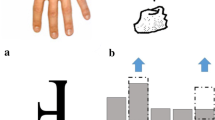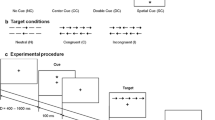Abstract
This study assessed the ability of mildly affected Parkinson's disease (PD) subjects (n=16) to perform attentional cognitive tasks within a three-dimensional object. A hollow cube was displayed on a computer screen and the subject was required to respond as quickly as possible to the highlighting of one of the cube angles by pressing the spacebar of the keyboard. Prior to the appearance of this imperative stimulus, the same (“valid” trials) or an alternative (“invalid” trials) angle was highlighted. For the invalid trials this meant that the subject oriented attention to the cued angle but, on imperative stimulus appearance, was unexpectedly required to redirect attention to another angle, which could be on a different cube face to that which had been cued. For one experimental session the cube was stationary, that is, object-centred and viewer-centred coordinates of a cube angle corresponded. For another session, the cube rotated such that the viewer-centred coordinates of an angle changed between appearance of the cue and appearance of the stimulus, but the angle's object-centred coordinates remained constant. The finding of lower reaction times for the valid than for the invalid trials, even when the cube was rotating, indicated that PD subjects could operate attention using an object-centred coordinate system. However, PD subjects showed exaggerated reaction times when the stimulus appeared in a cube face that was opposite to, rather than the same as, that of the invalidly cued angle. It is suggested that this reflects a dysfunction in the grouping of the structural components of the whole object at an attentional level.
Similar content being viewed by others
References
Andersen GJ (1990) Focused attention in three-dimensional space. Percept Psychophys 47:112–120
Andersen GJ, Kramer AF (1993) Limits of focused attention in three-dimensional space. Percept Psychophys 53:658–667
Behrmann M, Tipper SP (1995) Object-based attentional mechanisms: evidence from patients with unilateral neglect. In: Umiltà C, Moscovitch M (eds) Attention and performance XV. MIT Press, Cambridge, pp 351–375
Bennett KMB, Waterman C, Scarpa M, Castiello U (1995) Covert visuospatial attentional mechanisms in Parkinson's disease. Brain 118:156–166
Biederman I (1985) Human image understanding: recent research and a theory. Comput Vision Graphics Image Process 32:29–73
Braunstein ML, Tittle JS, Myers TS (1988) Size constancy in orthographic structure-from-motion projections. Invest Opthalmol Vis Sci 29:249
Brown RG, Marsden CD (1986) Visuospatial function in Parkinson's disease. Brain 109:987–1002
Caelli TM, Julesz B, Gilbert EN (1978) On perceptual analyzers underlying visual texture discrimination: part II. Biol Cybern 29:201–214
Caramazza A, Hillis AE (1990) Spatial representation of words in the brain implied by studies of a unilateral neglect patient. Nature 346:267–269
Crick F (1984) Function of the thalamic reticular complex: the searchlight hypothesis. Proc Natl Acad Sci 81:4586–4590
Downing CJ, Pinker S (1985) The spatial structure of visual attention. In: Posner MI, Marin OSM (eds) Attention and performance XI. Erlbaum, Hillsdale, NJ, pp 171–187
Driver J, Baylis GC (1989) Movement and visual attention: the spotlight metaphor breaks down. J Exp Psychol Hum Percept Perform 15:448–456
Driver J, Halligan PW (1991) Can visual neglect operate in objectcentred coordinates? An affirmative single-case study. Cogn Neuropsychol 8:475–496
Driver J, Baylis GC, Rafal RD (1992) Preserved figure-ground segregation and symmetry perception in visual neglect. Nature 360:73–75
Duncan J (1984) Selective attention and the organization of visual information. J Exp Psychol Gen 113:501–517
Egly R, Driver J, Rafal RD (1994) Shifting visual attention between objects and locations: evidence from normal and parietal lesion subjects. J Exp Psychol Gen 23:161–177
Epstein W, Broota K (1986) Automatic and attentional components in perception of size-at-a-distance. Percept Psychophys 40:256–262
Epstein W, Lovitts B (1985) Automatic and attentional components in perception of shape-at-a-slant. J Exp Psychol Hum Percept Perform 11:355–366
Eriksen CW, Yeh YY (1985) Allocation of attention in the visual field. J Exp Psychol Hum Percept Perform 11:583–98
Folstein MF, Folstein SE, McHugh PR (1975) “Mini-Mental State”: a practical method for grading the cognitive state of patients for the clinician. J Psychosom Res 12:189–198
Gawryszewski LDG, Riggio L, Rizzolatti G, Umiltà C (1987) Movements of attention in the three dimensions and the meaning of “neutral” cues. Neuropsychologia 25:19–29
Gibson BS, Egeth H (1994) Inhibition of return to object-based and environment-based locations. Percept Psychophys 55:323–339
Hazrati L-N, Parent A (1991) Projection from the external pallidum to the reticular thalamic nucleus in the squirrel monkey. Brain Res 550:142–146
Hochberg J, Peterson M (1987) Piecemeal organization and cognitive components in object perception: perceptually coupled responses to moving objects. J Exp Psychol Gen 116:370–380
Hoehn MM, Yahr MD (1967) Parkinsonian onset, progression and mortality. Neurology 17:427–442
Humpreys GW, Riddoch MJ (1993) Interactions between object and space systems revealed through neuropsychology. In: Meyer DE, Kornblum S (eds) Attention and performance XIV. Erlbaum, Hillsdale, NJ, pp 212–231
Jackson S, Houghton G (1992) Basal ganglia function in the control of visuospatial attention: a neural-network model. Technical report 92-6, Institute of Cognitive and Decision Sciences, University of Oregon
Julesz B (1981) Textons, the element of texture perception, and their interactions. Nature 290:91–97
La Berge D, Brown V (1989) Theory of attentional operations in shape identifications. Psychol Rev 96:101–104
Marr, D (1982) Vision. San Francisco:WH Freeeman
Nawrot M, Blake R. (1989) Neural integration of information specifying structure from stereopsis and motion. Science 244:716–718
O'Brien RG (1971) A simple test for variance effects in experimental designs. Psychol Bull 89:570–574
Oldfield RC (1971) The assessment and analysis of handedness: the Edinburgh Inventory. Neuropsychologia 9:97–113
Pare D, Hazrati L-N, Parent A, Steriade M (1990) Substantia nigra pars reticulata projects to the reticular thalamic nucleus in the cat: a morphological and electrophysiological study. Brain Res 535:139–146
Peterson M (1986) Illusory concomitant motion in ambiguous stereograms: evidence for nonstimulus contributions to perceptual organization. J Exp Psychol Hum Percept Perform 12:50–60
Posner MI (1980) Orienting of attention. Q J Exp Psychol 109:160–174
Posner MI, Peterson SE (1990) The attention system of the human brain. Annu Rev Neurosci 13:25–42
Posner MI, Snyder CR, Davidson BJ (1980) Attention and the detection of signals. J Exp Psychol 109:160–74
Prinzmetal W (1981) Principles of feature integration in visual perception. Percept Psychophys 30:330–340
Rafal RD, Posner MI, Walker JA, Frances J, Friedrich FJ (1984) Cognition and the basal ganglia: separating mental and motor components of performance in Parkinson's disease. Brain 107:1083–1094
Schlag J, Schlag-Rey M (1983) Interface of visual input and oculomotor command for directing the gaze on target. In: Hein A, Jeannerod M (eds) Spatially oriented behavior. Springer, New York, pp 87–98
Sharpe MH (1990) Distractibility in early Parkinson's disease. Cortex 26:239–46
Shulman GL (1991) Attentional modulation of mechanisms that analyze rotation in depth. J Exp Psychol Hum Percept Perform 17:726–737
Tipper SP, Weaver B, Jerreat LM, Burak AL. (1994) Object-based and environment-based inhibition of return of visual attention. J Exp Psychol Hum Percept Perform 20:478–499
Treisman A, Paterson R. (1984) Emergent features, attention and object perception. J Exp Psychol 10:12–31
Umiltà C, Castiello U, Fontana M, Vestri A (1995) Object-centred orienting of attention. Visual Cogn 2:165–181
Vecera SP, Farah MJ (1994) Does visual attention select objects or locations? J Exp Psychol Hum Percept Perform 123:146–160
Wright MJ, Burns RJ, Geffen GM, Geffen LB (1990) Covert orientation of visual attention in Parkinson's disease: an impairment in the maintenance of attention. Neuropsychologia 28:151–159
Yamada T, Izyuunn M, Schulzer M, Hirayama K (1990) Covert orienting of attention in Parkinson's disease. J Neurol Neurosurg Psychiatry 53:593–6
Author information
Authors and Affiliations
Rights and permissions
About this article
Cite this article
Bennett, K.M.B., Castiello, U. Three-dimensional covert attentional functions in Parkinson's disease subjects. Exp Brain Res 112, 277–288 (1996). https://doi.org/10.1007/BF00227646
Received:
Accepted:
Issue Date:
DOI: https://doi.org/10.1007/BF00227646




